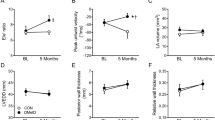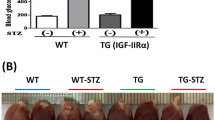Abstract
Heart failure in chronic type 2 diabetes mellitus is partly attributable to adverse structural remodelling of the left ventricle (LV), but the contribution of hyperglycaemia (HG) per se in remodelling processes is debated. In this study, we examined the molecular signature of LV remodelling in 18-month-old spontaneously diabetic male Goto-Kakizaki (GK) rats that represent a long-term mildly diabetic phenotype, using histological, immunoblotting and quantitative gene expression approaches. Relative to age-matched Wistar controls, mildly diabetic GK rats presented with LV hypertrophy, increased expression of natriuretic peptides and phosphorylation of pro-hypertrophic Akt. Fibrosis proliferation in the GK LV paralleled increased transcriptional and biologically active pro-fibrogenic transforming growth factor-β1 (TGFβ1) in the LV with upregulated mRNA abundance for key extracellular matrix (ECM) components such as fibronectin, collagen type(s) 1 and 3α and regulators including matrix metalloproteinases 2 and 9, and their tissue inhibitor (TIMP) 4, connexin 43 and α5-integrin. GK rats also presented with altered mRNA expression for cardiac sarcoplasmic reticulum Ca2+ATPase, Na+/Ca2+ exchanger and the L-type Ca2+ channels which may contribute to the altered Ca2+ transient kinetics previously observed in this model at 18 months of age (t test, p < 0.05 vs. age-matched Wistar control for all parameters). The results indicate that chronic mild HG can produce the molecular and structural correlates of a hypertrophic myopathy. Diffuse ECM proliferation in this model is possibly a product of HG-induced TGFβ1 upregulation and altered transcriptional profile of the ECM.





Similar content being viewed by others
References
Verny C (2007) Congestive heart failure in the elderly diabetic. Diabetes Metab 33(1):S32–S39
Jugdutt BI (2010) Aging and heart failure: changing demographics and implications for therapy in the elderly. Heart Fail Rev 15(5):401–405
UK Prospective Diabetes Study (UKPDS) Group (1998) Effect of intensive blood-glucose control with metformin on complications in overweight patients with type 2 diabetes (UKPDS 34). Lancet 352:654–854
Duckworth W, Abraira C, Moritz T et al (2009) Glucose control and vascular complications in veterans with type 2 diabetes. N Engl J Med 360:129–139
Action to Control Cardiovascular Risk in Diabetes Study Group (2008) Effects of intensive glucose lowering in type 2 diabetes. N Engl J Med 358:2545–2559
Wold LE, Ren J (2004) Streptozotocin directly impairs cardiac contractile function in isolated ventricular myocytes via a p38 map kinase-dependent oxidative stress. Biochem Biophys Res Commun 318(4):1066–1071
Portha B, Serradas P, Baille D, Suzuki KI et al (1991) B-cell insensitivity to glucose in the GK rat, a spontaneous non-obese model for type II diabetes. Diabetes 40:486–491
Howarth FC, Shafiullah M, Qureshi MA (2007) Chronic effects of type 2 diabetes mellitus on cardiac muscle contraction in the Goto-Kakizaki rat. Exp Physiol 92:1029–1103
Ramos-Mondragon R, Galindo CA, Avila G (2008) Role of TGF-β on cardiac structural and electrical remodelling. Vasc Health Risk Manag 4(6):1289–1300
Wu L, Derynck R (2009) Essential role of TGF-β signalling in glucose-induced cell hypertrophy. Dev Cell 17:35–48
D’Souza A, Howarth FC, Yanni J, Dobrzynski H, Boyett MRB et al (2011) Left ventricle structural remodelling in the prediabetic Goto-Kakizaki rat. Exp Physiol 96(9):875–888
Tellez JO, Maczewski M, Sutyagin PV, Mackiewicz U, Yanni J, Atkinson A et al (2011) Ageing-dependent remodelling of ion channel and Ca2 + clock genes underlying sinoatrial node pacemaking. Exp Physiol 96(11):1163–1178
Shi SR, Key ME, Kalra KL (1991) Antigen retrieval in formalin-fixed, paraffin-embedded tissues: an enhancement method for immunohistochemical staining based on microwave oven heating of tissue sections. J Histochem Cytochem 39:741–748
Zheng H, Mayhan WG, Bidasee KR et al (2005) Blunted nitric oxide-mediated inhibition of sympathetic nerve activity within the paraventricular nucleus in diabetic rats. Am J Physiol Regul Integr Comp Physiol 290:R992–R1002
Yanni J, Tellez JO, Sutyagin PV et al (2010) Structural remodelling of the sinoatrial node in obese old rats. J Mol Cell Cardiol 48(4):653–662
Tellez JO, Dobrzynski H, Greener ID et al (2006) Differential expression of ion channel transcripts in atrial muscle and sinoatrial node in rabbit. Circ Res 99:1384–1393
American diabetes Association (2010) Diagnosis and classification of diabetes mellitus. Diabetes Care 33(1):S62–S69
Schrijvers BF, De Vriese AS, Van de Voorde J, Rasch R et al (2004) Long-term renal changes in the Goto-Kakizaki rat, a model of lean type 2 diabetes. Nephrol Dial Transplant 19(5):1092–1097
Gaede P, Hildebrandt P, Hess G et al (2005) Plasma N-terminal pro-brain natriuretic peptide as a major risk marker for cardiovascular disease in patients with type 2 diabetes and microalbuminuria. Diabetologia 48:156–163
Hescheler J, Fleischmann BK (2000) Integrins and cell structure:powerful determinants of heart development and heart function. Cardiovasc Res 47(4):645–647
Houser SR, Piacentino V, Weisser J (2000) Abnormalities of calcium cycling in the hypertrophied and failing heart. J Mol Cell Cardiol 32:1595–1607
Duncan JC, Fletcher WH (2002) Alpha 1 Connexin (connexin43) gap junctions and activities of cAMP-dependent protein kinase and protein kinase C in developing mouse heart. Dev Dyn 223:96–107
Alessi DR, Kozlowski MT, Weng QP et al (1998) 3-phosphoinositide-dependent protein kinase 1 (PDK1) phosphorylates and activates the p70 S6 kinase in vivo and in vitro. Curr Biol 8(2):69–81
Wang X, Beugnet A, Murakami M et al (2005) Distinct signalling events downstream of mTOR cooperate to mediate the effects of Amino acids and insulin on initiation factor 4E-Binding proteins. Mol Cell Biol 25(7):2558–2752
Smoak IW (2004) Hyperglycemia-induced TGFβ and fibronectin expression in embryonic mouse heart. Dev Dyn 231(1):179–189
Berk B, Fujiwara K, Lehoux S (2007) ECM remodelling in hypertensive heart disease. J Clin Invest 117(3):568–575
Manso AM, Elsherif L, Kang SM et al (2006) Integrins, membrane-type matrix metalloproteinases and ADAMs: potential implications for cardiac remodeling. Cardiovasc Res 69:574–584
Kurrelmeyer K, Kalra D, Bozkurt B, Wang F et al (1998) Cardiac remodeling as a consequence and cause of progressive heart failure. Clin Cardiol 12(1):114–119
Ares-Carrasco S, Picatoste B, Benito-Martin A et al (2009) Myocardial fibrosis and apoptosis, but not inflammation, are present in long-term experimental diabetes. Am J Physiol Heart Circ Physiol 297:H2109–H2119
Falcão-Pires I, Gonçalves N, Moura C et al (2009) Effects of diabetes mellitus, pressure-overload and their association on myocardial structure and function. Am J Hypertens 22(11):1190–1198
Van Heerebeek L, Paulus WJ (2007) Invasive evaluation of diastolic left ventricular dysfunction. In: Smiseth O, Tendera M (eds) Diastolic heart failure. Springer, London, pp 137–148
McMullen JR, Shioi T, Li Z et al (2004) Deletion of ribosomal S6 kinases does not attenuate pathological, physiological, or insulin-like growth factor 1 receptor-phosphoinositide 3-kinase-induced cardiac hypertrophy. Mol Cell Biol 24:6231–6240
O’Neill BT, Abel ED (2005) Akt1 in the cardiovascular system: friend or foe? J Clin Invest 115(8):2059–2064
McMullen JR, Sherwood MC, Tarnavski O et al (2004) Inhibition of mTOR signaling with rapamycin regresses established cardiac hypertrophy induced by pressure overload. Circulation 109:3050–3055
Kapoun AM, Liang A, O’Young G, Damm DL et al (2004) B-type natriuretic peptide exerts broad functional opposition to transforming growth factor-beta in primary human cardiac fibroblasts: fibrosis, myofibroblast conversion, proliferation, and inflammation. Circ Res 94:453–461
McCulloch DK (2010) Management of persistent hyperglycemia in type 2 diabetes mellitus. Waltham MA UpToDate. Available via http://www.uptodate.com/contents/management-of-persistent-hyperglycemia-in-type-2-diabetes-mellitus. Accessed 5 Apr 2012
Conflict of interest
None.
Author information
Authors and Affiliations
Corresponding author
Electronic supplementary material
Below is the link to the electronic supplementary material.
Rights and permissions
About this article
Cite this article
D’Souza, A., Howarth, F.C., Yanni, J. et al. Chronic effects of mild hyperglycaemia on left ventricle transcriptional profile and structural remodelling in the spontaneously type 2 diabetic Goto-Kakizaki rat. Heart Fail Rev 19, 65–74 (2014). https://doi.org/10.1007/s10741-013-9376-9
Published:
Issue Date:
DOI: https://doi.org/10.1007/s10741-013-9376-9




